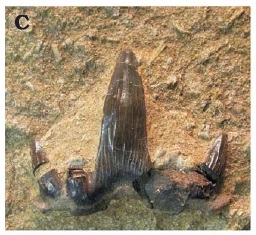
The Permian is a geologic period and stratigraphic system which spans 47 million years from the end of the Carboniferous Period 298.9 million years ago (Mya), to the beginning of the Triassic Period 251.902 Mya. It is the last period of the Paleozoic Era; the following Triassic Period belongs to the Mesozoic Era. The concept of the Permian was introduced in 1841 by geologist Sir Roderick Murchison, who named it after the region of Perm in Russia.

Xenacanthida is an order or superorder of extinct shark-like chondrichthyans known from the Carboniferous to Triassic. They were native to freshwater, marginal marine and shallow marine habitats. Some xenacanths may have grown to lengths of 5 m (16 ft). Most xenacanths died out at the end of the Permian in the End-Permian Mass Extinction, with only a few forms surviving into the Triassic.

The Kaibab Limestone is a resistant cliff-forming, Permian geologic formation that crops out across the U.S. states of northern Arizona, southern Utah, east central Nevada and southeast California. It is also known as the Kaibab Formation in Arizona, Nevada, and Utah. The Kaibab Limestone forms the rim of the Grand Canyon. In the Big Maria Mountains, California, the Kaibab Limestone is highly metamorphosed and known as the Kaibab Marble.

Glikmanius is an extinct genus of ctenacanth cartilaginous fish which lived in the Carboniferous of North America and Russia. The genus is based on a whole specimen from Nebraska, USA. Glikmanius is named in honour of the Russian palaeontologist, Dr. Leonid Glikman, who studied the genus and was "the first to propose its ctenacanthiform affinity". G. careforum may have reached lengths of 3 metres (9.8 ft), while G. occidentalis may have reached lengths of over 6 metres (20 ft), making it one the largest marine predators of its era.

Hybodontiformes, commonly called hybodonts, are an extinct group of shark-like cartilaginous fish (chondrichthyans) which existed from the late Devonian to the Late Cretaceous. Hybodonts share a close common ancestry with modern sharks and rays (Neoselachii) as part of the clade Euselachii. They are distinguished from other chondrichthyans by their distinctive fin spines and cephalic spines present on the heads of males. An ecologically diverse group, they were abundant in marine and freshwater environments during the late Paleozoic and early Mesozoic, but were rare in open marine environments by the end of the Jurassic, having been largely replaced by modern sharks, though they were still common in freshwater and marginal marine habitats. They survived until the end of the Cretaceous, before going extinct.
Kourerpeton is an extinct genus of dvinosaurian temnospondyl. Fossils of Kourerpeton were discovered in a window of a barber's shop in either Bisbee or Mesa, Arizona. Kourerpeton was named in 1976, with the type and only species being K. bradyi. It was originally assigned to the monotypic family Kourerpetidae, which has been alternatively spelled Kourerpetontidae.
Christian Alfred Sidor is an American vertebrate paleontologist. He is currently a Professor in the Department of Biology, University of Washington in Seattle, as well as Curator of Vertebrate Paleontology and Associate Director for Research and Collections at the Burke Museum of Natural History and Culture. His research focuses on Permian and Triassic tetrapod evolution, especially on therapsids.

Paleontology in Oklahoma refers to paleontological research occurring within or conducted by people from the U.S. state of Oklahoma. Oklahoma has a rich fossil record spanning all three eras of the Phanerozoic Eon. Oklahoma is the best source of Pennsylvanian fossils in the United States due to having an exceptionally complete geologic record of the epoch. From the Cambrian to the Devonian, all of Oklahoma was covered by a sea that would come to be home to creatures like brachiopods, bryozoans, graptolites and trilobites. During the Carboniferous, an expanse of coastal deltaic swamps formed in areas of the state where early tetrapods would leave behind footprints that would later fossilize. The sea withdrew altogether during the Permian period. Oklahoma was home a variety of insects as well as early amphibians and reptiles. Oklahoma stayed dry for most of the Mesozoic. During the Late Triassic, carnivorous dinosaurs left behind footprints that would later fossilize. During the Cretaceous, however, the state was mostly covered by the Western Interior Seaway, which was home to huge ammonites and other marine invertebrates. During the Cenozoic, Oklahoma became home to creatures like bison, camels, creodonts, and horses. During the Ice Age, the state was home to mammoths and mastodons. Local Native Americans are known to have used fossils for medicinal purposes. The Jurassic dinosaur Saurophaganax maximus is the Oklahoma state fossil.
This list of fossil fish species is a list of taxa of fish that have been described during the year 2012. The list only includes taxa at the level of genus or species.
This list of fossil fishes described in 2013 is a list of new taxa of placoderms, fossil cartilaginous fishes and bony fishess of every kind that have been described during the year 2013. The list only includes taxa at the level of genus or species.
The Vale Formation is a geological formation in north-central Texas, a component of the Texas red beds preserving sediments and fossils from the Early Permian Leonardian series. It occupies the middle part of the Clear Fork Group, above the Arroyo Formation and below the Choza Formation. Some sources consider the Vale Formation to be merely an informal subunit of the Clear Fork Formation, thus renaming it to the Middle Clear Fork Formation.
The San Angelo Formation is a geologic formation in Texas. It preserves fossils dating back to the Permian period. Along with the Chickasha Formation is one of the two geologically youngest formations in North America to preserve fossils of caseids, and it is the youngest one to preserve remains of undoubted sphenacodontids, namely, Dimetrodon angelensis.
The Nocona Formation is a geological formation in Texas, dating back to the Wolfcampian series. As part of the Texas red beds, it is one of several formations renowned for dense bonebeds of terrestrial vertebrate fossils.

Gregoriidae is an extinct family of early chondrichthyans from the Carboniferous period. It currently includes three described genera: Gregorius, Srianta, and Bealbonn. This family includes remains formerly ascribed to "Desmiodus," which is now considered a nomen vanum. The relationships between the included genera are not entirely clear. Fossils are known from Serpukhovian-aged formations including the Bear Gulch Limestone and Surprise Canyon Formation.

Ctenacanthiformes is an extinct order of cartilaginous fish. They possessed ornamented fin spines at the front of their dorsal fins and cladodont-type dentition, that is typically of a grasping morphology, though some taxa developed cutting and gouging tooth morphologies. Some ctenacanths are thought to have reached sizes comparable to the great white shark, with body lengths of up to 7 metres (23 ft) and weights of 1,500–2,500 kilograms (3,300–5,500 lb). The earliest ctenacanths appeared during the Frasnian stage of the Late Devonian, with the group reaching their greatest diversity during the Early Carboniferous (Mississippian), and continued to exist into at least the Middle Permian (Guadalupian). Some authors have suggested members of the family Ctenacanthidae may have survived into the Cretaceous based on teeth found in deep water deposits of Valanginian age in France and Austria, however, other authors contend that the similarity of these teeth to Paleozoic ctenacanths is only superficial, and they likely belong to neoselachians instead.
This list of fossil fish research presented in 2021 is a list of new taxa of jawless vertebrates, placoderms, acanthodians, fossil cartilaginous fishes, bony fishes, and other fishes that were described during the year, as well as other significant discoveries and events related to paleoichthyology that occurred in 2021.

Dracopristis is an extinct genus of ctenacanth that lived around 307 million years ago, during the Pennsylvanian sub-period of the Carboniferous period. The fish had 12 rows of short, squat teeth, and an array of spines on its dorsal fins. The main differentiation between ctenacanthiformes and true sharks is that ctenacanthiform mouths are larger but less flexible than the true sharks. The spines of the holotype fossil are about 0.57 meters long, and the whole body was around 2 meters (6 ft) long.
Saivodus is an extinct genus of ctenacanthiform fish that existed in early Mississippian of the Carboniferous period. Fossils have been found in Ireland, Scotland, England, Belgium, Morocco, and the United States. Teeth assigned to that genus are also known from the Permian (Leonardian) Kaibab Formation.
This list of fossil fish research presented in 2023 is a list of new fossil taxa of jawless vertebrates, placoderms, cartilaginous fishes, bony fishes, and other fishes that were described during the year, as well as other significant discoveries and events related to paleoichthyology that occurred in 2023.

Strigilodus is an extinct genus of cartilaginous fish within the order Petalodontiformes. This genus existed during the Lower Carboniferous period, approximately 350 million years ago.















